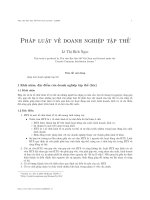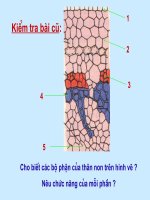Bài giảng Violent collision of Antegrade with retrograde coronary flow causing the first endothelial injury, starting a plaque and breaking the cap of vulnerable plaques
Bạn đang xem bản rút gọn của tài liệu. Xem và tải ngay bản đầy đủ của tài liệu tại đây (2.57 MB, 26 trang )
Violent Collision of Antegrade with Retrograde
Coronary Flow Causing the First Endothelial
Injury, Starting a Plaque and Breaking the Cap
of Vulnerable Plaques
The 10th Central Vietnam Open Congress of Cardiology
14:05-14:20 Friday July 12th 2019
Thach Nguyen, MD FACC FSCAI
Tan Tao U, School of Medicine, Long An Vietnam,
Methodist Hospital Merrillville IN USA,
Background 1
How to create an animal model for
atheroslerosis
hinhanhykhoa.com
Background 2
It starts with a mechanical injury
Background 3: The inside of a pipe is damage
by air bubble rupture (cavitation)
/>ce/v56n3/08.pdf
Background 2
How to show the evidence of the injuries in
the endothelium of the (mainly coronary)
arteries? What is the mechanism?
Background
• In hydraulic studies, the
damage in the pipelines is due
to the bursting of air bubbles.
• During diastole, bubbles
would form when the local
dynamic coronary pressure
decreases below the vapor
pressure (VP) of gases in the
blood.
• WHICH GAS?
Background
The bubbles
explode when the
dynamic coronary
pressure recovers
above the vapor
pressure.
Figue 2: Bubble Formation and Implosion. Formation
of a bubble and its burst creating micro-jets
Background
• When the bubbles explode,
the endothelial layer is
damaged and lets the LDL
particles pass through and
form the cholesterol
plaques.
hinhanhykhoa.com
Methods
• Select the coronary
angiograms with one or two
mild lesions.
• Review angiogram at 15
frames per second
– The left main (LM) .
– The proximal left anterior
descending (LAD) and
left circumflex (LCX)
– The right coronary artery
(RCA)
Methods
Figure 3.
To review the coronary
angiogram frame by frame
at 15 frames per second,
first right click and then
select Key Image option,
then use the up and down
arrows to move the
picture, one at a time.
hinhanhykhoa.com
Methods
• In the angiogram of the right
coronary artery, the lesion was
seen at the mid-segment
(arrow).
• No lesion was seen in proximal
or distal segment (WHY?)
Methods
• Laminar flow is a well
organized flow with
peripheral layer, regular
border and a pointed tip.
• It represents uniform
distribution of pressure
hinhanhykhoa.com
Methods
• Turbulent flow is
defined as coarse
mixing of blood
in white and
contrast in black
Methods
• To compare the type of flow of same patient between
the Right Coronary Artery (RCA) (with turbulent flow)
and the Left Circumflex Artery (LCX) without
turbulent flow
• (same risk factors: HTN, hyperlipidemia, etc)
hinhanhykhoa.com
Methods
• Baseline angiogram of the
left circumflex artery
without lesion
•
Methods
• The flow at the left circumflex
artery was laminar without
turbulence flow in systole and
in diastole
hinhanhykhoa.com
Methods
• In the angiogram of the right
coronary
artery,
multiple
plaques were seen at the midsegment (arrow).
• No lesion was seen in proximal
or distal segment
Methods
• The flow study of the right
coronary artery with multiple
areas of turbulence (coarse
mixing of contrast in black and
blood in white) at the
midsegment. This is the same
area with multiple plaques in
the previous slide
hinhanhykhoa.com
Methods
Methods
nd
(2 ,
rd
3 3th,
th
6
frame)
Methods
th
(11 ,
th
12 ,
th
14 ,
th
16
frame)
Results
• In 20 coronary angiograms we see the following results:
• 80% of flow in the mid segment were turbulent and they
happened in the area with multiple lesions
• Only 10% lesion happened in the area without turbulence
CONCLUSIONS
1. TURBULENT FLOW at the mid segment of the
right, circumflex and left anterior descending artery
arteries coincide with the presence of atherosclerotic
lesions
2. This is the indirect evidence of the formation of
coronary plaques caused by mechanical injury to
the endothelium and the birth of coronary plaques.









